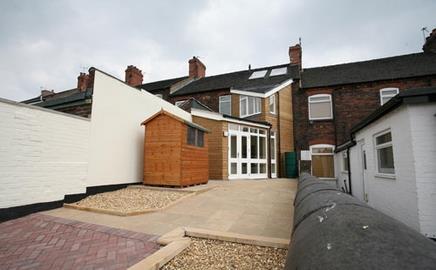Winner: Axis Design
The ecoterrace, a highly ambitious project in Newcastle, has been launched to show how Victorian housing stock can be transformed to meet today’s housing standards. Six pre-1919 terraced houses with energy performance certificate (EPC) ratings of F and G are undergoing radical refurbishment, which aims to turn them into modern, efficient and highly sustainable dwellings. The really impressive part of ecoterrace is the commitment of the team to sharing its ideas and experiences with the rest of the world. A website – www.ecoterrace.co.uk – is charting the scheme’s progress, with regularly updated information, images and a blog. And a two-year monitoring programme will assess the value of the changes introduced. Project aims include lifting the houses from an EPC banding of G to B, or even A – a carbon saving of almost five tonnes per year per house and cutting heating costs to £200 a year. The sun is central to the design strategy. Angled sunspaces and glazed walls and doors are being used to create light, airy rooms – a stark contrast to the dark backrooms of traditional terraced houses. The ecoterrace, which is a partnership between Staffordshire Housing Association, Newcastle under Lyme council and Renew North Staffs, is set to provide a invaluable boost to the refurbishment of pre-1919 stock, most of which is privately owned or rented.
Runners up
3D Reid
The refurbishment of this Marks & Spencer in Bournemouth was so successful that the building now uses 25% less energy than the chain’s traditional stores. The 70-year-old building has been rated as BREEAM “very good”, which is unsurprising given the thoroughness of the refurb. New lighting, refrigeration, heating and ventilation systems have helped to cut energy consumption while a range of measures, such as dual flush toilets and self-closing taps, has resulted in average water savings of 15%. Other notable features include glazed lobbies to improve insulation and a green roof to boost bio-diversity. Outside the building, new trees have been planted and timber street furniture added.
Cundall
Cundall took on the massive project of refurbishing the 325,000ft
2 building at 50 Queen Anne’s Gate in London for Land Securities and has successfully delivered a sustainable refurbishment in the heart of the capital. At the centre of the £100m project, designed by architect Aukett Fitzroy Robinson, was an overhaul of the building’s cladding. All glazing was replaced with high performance Low E glass, which allows daylight in while cutting solar gain by around 60% and retaining heat in winter. High efficiency boilers, chillers, fans and active chilled beams were also introduced throughout the offices and cycling facilities provided to encourage staff to use green transport. The scheme was carried out with minimal waste – more than half of the existing façade and 80% of the structure was reused.
Green Structures
Green Structures covered all corners with this prototype zero-carbon loft conversion. Insulation was boosted with triple-glazed windows, aluminium-backed thermal blinds and airtightness measures, while low energy lighting, solar shading and a dedicated drying area helped cut energy consumption. Other sustainable measures include a wind turbine, grey water recycling system, green roof and bicycle storage. The team worked hard to minimise the environmental impact of the refurbishment itself – most of the existing timber was reused, all new material was FSC-certified and all waste was sorted on site.
Morgan Lovell
Until recently, Morgan Lovell’s London office in Soho might have been considered an environmental write-off. The two-floor office in a seven-storey 1960s block was not the most obvious candidate to become a showcase, sustainable workplace. But the design team pulled it off and achieved an “excellent” rating under the BREEAM fit-out assessment (for which it was one of the pilot projects) – one of just two developments to do so to date. Eco features include energy-saving sensors for lighting and built-in recycling points across the building. Morgan Lovell has continued its campaign to help improve sustainability in office blocks by hosting green seminars in its new office and allowing property professionals in to see the changes first hand.
Simons Group
When Simons Group chose a disused 1970s block in Lincoln for one of its businesses’ new headquarters, it wanted to demonstrate that a refurbished office could provide high quality space with low emissions. Since completing the project in 2006, its efforts haven’t stopped. At the end of the first year, it commissioned the Carbon Trust to carry out a survey of the scheme and produce energy saving ideas that could cut emissions by a further 20 to 40 tonnes. And this year it supported a study by Lincoln and Sheffield universities into thermal performance. Green initiatives in this scheme include permeable parking surfaces to limit water run-off, lights with movement sensors and rainwater harvesting to cover 50% of toilet flushing needs.


























